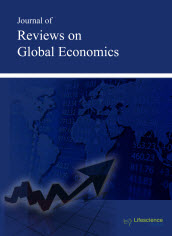Assessment of Regional Economic Security Level in Innovative Development
DOI:
https://doi.org/10.6000/1929-7092.2020.09.11Keywords:
Regions, innovative component, economic security, calculation methods.Abstract
Analysis of the innovative development of the regional economy is a relevant problem due to its role in ensuring the economic security of the country and achieving priority goals. The subject of the research are the regions of one of Russia's most dynamically developing macro-regions – the Volga Federal District. It features innovation clusters, a network of modern manufacturing companies, research organizations. At the same time, it developed a significant territorial heterogeneity of the regional space.
Therefore, in the course of the study, a typology of the regions was drafted according to a number of indicators, which made it possible to assess the level of their innovative development and identify zones of relative stability, medium and critical state. A forecast of the main indicators of the innovation component was made showing the ability of the regions to overcome the factors preventing the development of the innovation economy.
The research results showed that most of the regions have a medium level of economic security in the field of innovation. The Nizhny Novgorod Region and the Republic of Tatarstan are at a high level. The economy of these regions is characterized by a high level of diversification, resilience to instability in the domestic market and external challenges. The Saratov region, the Republic of Mari El and the Orenburg Region are in a low-level zone. A short-term forecast indicates that in general the situation will not change – the regions will increase or decrease the values of the indices within the achieved levels of economic security. A qualitative transition to a new level is possible provided that the problems that hinder the innovative economy in the regions are eliminated.
References
https://doi.org/10.15405/epsbs.2019.04.13
Brusov P.N., Filatova T.V., Orekhova N.P., Kulik V.L. and Weil I.. Ratings of The Investment Projects of Arbitrary Durations: New Methodology // Journal of Reviews on Global Economics. - 2019. - ? 8. - P. 437-448.
Decree of the President of the Russian Federation of May 13, 2017 No. 208 “On the Strategy for the Economic Security of the Russian Federation for the period until 2030”. (Text)– URL: https://img.rg.ru/pril/140/28/53/strategiya2030.pdf
Federal state statistics service. region of Russia. Socio-economic indicators-2017. - URL: http://www.gks.ru
Glazyev S.Yu. The basis for ensuring the economic security of the country. Alternative Reformation course // Russian Journal. 1997. No. 1.
Gusev A.B. Formation of ratings of innovative development of Russian regions / A. B. Gusev // Science. Innovation education. - 2018. - Issue. 8. - S. 158–173.
Independent Institute of Social Policy of the Russian Federation. (Text) – URL: http://www.socpol.ru/atlas/indexes/index_ innov.shtml#methods
Kormishkina L.A., Kormishkin E.D., Koloskov D.A. Investments of innovative type as the most important condition for the neoindustrial development of the Russian economy. Journal of Applied Economic Sciences. 12(7), ?. 2085-2100. 2017.
Lukashenko I.V., Fedorova E.A. Evaluation of Cultural Impact on Regional Economic Development in Russia // Journal of Reviews on Global Economics. - 2018. - ? S. - P. 572-581.
https://doi.org/10.6000/1929-7092.2018.07.53
Nikitskaya E.F., Safronova A.A., Zhidkova O.N., Ivanova-Shvets L.N., Mamedova N.A. Evolutionary aspects of innovation development. // Life Science Journal 11(8), ?. 516-519. 2014.
Nosova S.S., Makar S.V., Chapljuk V.Z., Medvedeva A.M., Semenova A.N. Collaborative nature of innovative economy. Espacios. 39 (41). 2018.
Senchagov V.K., Mityakov S.N. Using the index method to assess the level of economic security // Bulletin of the Academy of Economic Security of the Ministry of Internal Affairs of Russia. - 2015. - No. 5. - S. 41-50.
Zhukovskaya I.V., Shinkevich M.V., Vasilyeva A.V., Berezina N.V., Popova N.F. Regional zones of innovative economy growth on the example of reproduction capital concept modeling. Espacios. 39 (9), 26. 2018.
Downloads
Published
How to Cite
Issue
Section
License
Policy for Journals/Articles with Open Access
Authors who publish with this journal agree to the following terms:
- Authors retain copyright and grant the journal right of first publication with the work simultaneously licensed under a Creative Commons Attribution License that allows others to share the work with an acknowledgement of the work's authorship and initial publication in this journal.
- Authors are permitted and encouraged to post links to their work online (e.g., in institutional repositories or on their website) prior to and during the submission process, as it can lead to productive exchanges, as well as earlier and greater citation of published work
Policy for Journals / Manuscript with Paid Access
Authors who publish with this journal agree to the following terms:
- Publisher retain copyright .
- Authors are permitted and encouraged to post links to their work online (e.g., in institutional repositories or on their website) prior to and during the submission process, as it can lead to productive exchanges, as well as earlier and greater citation of published work .






